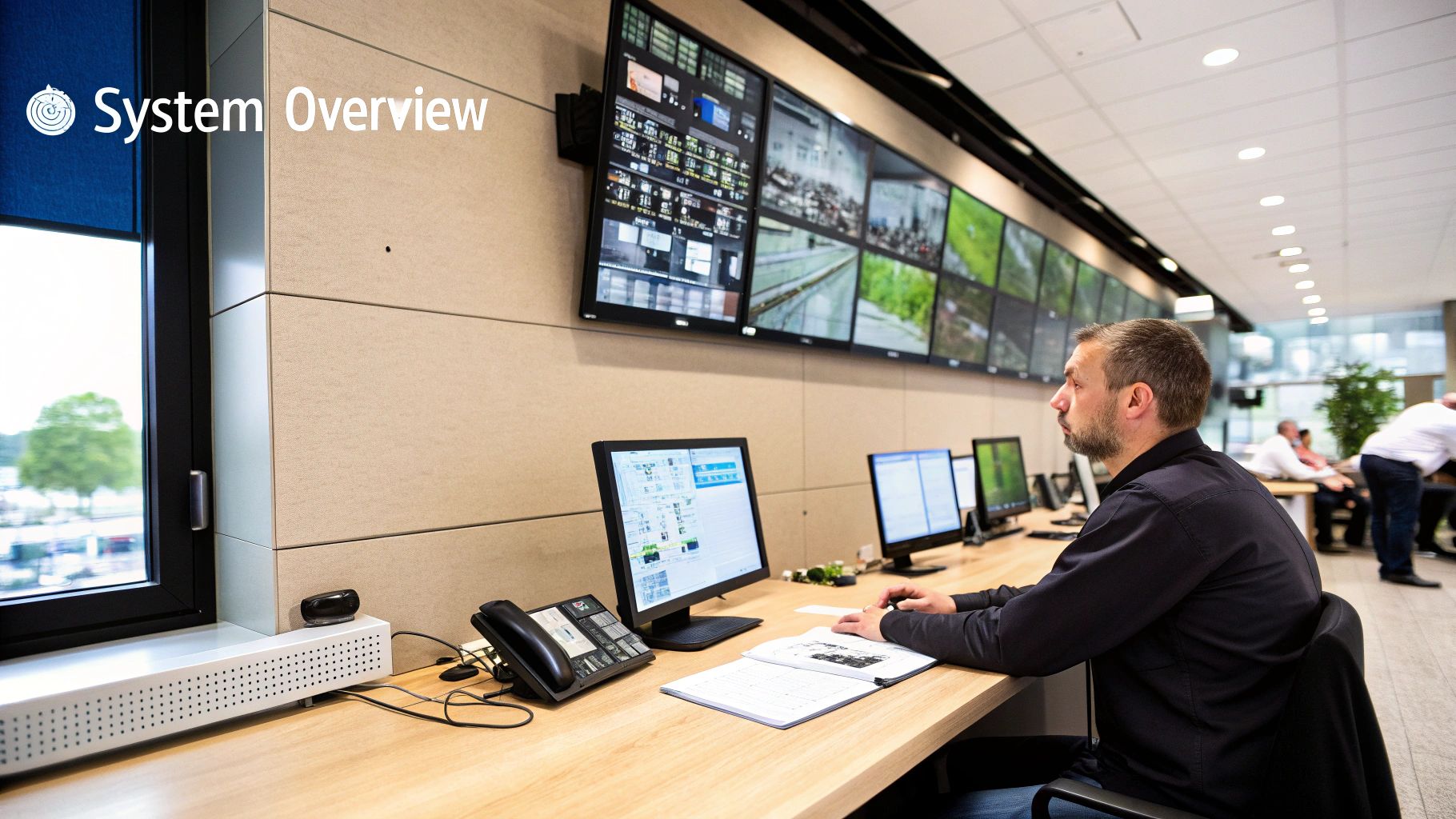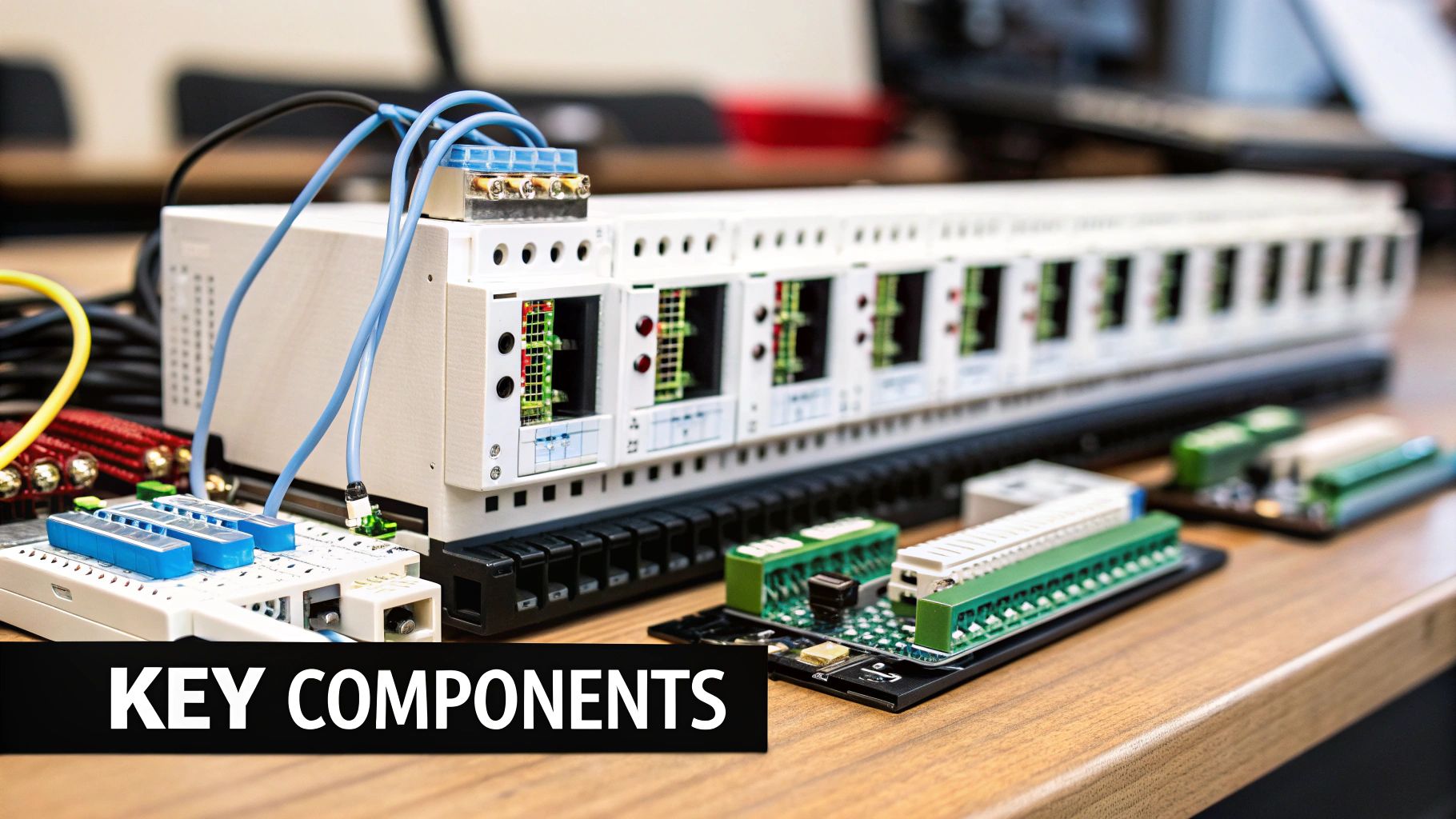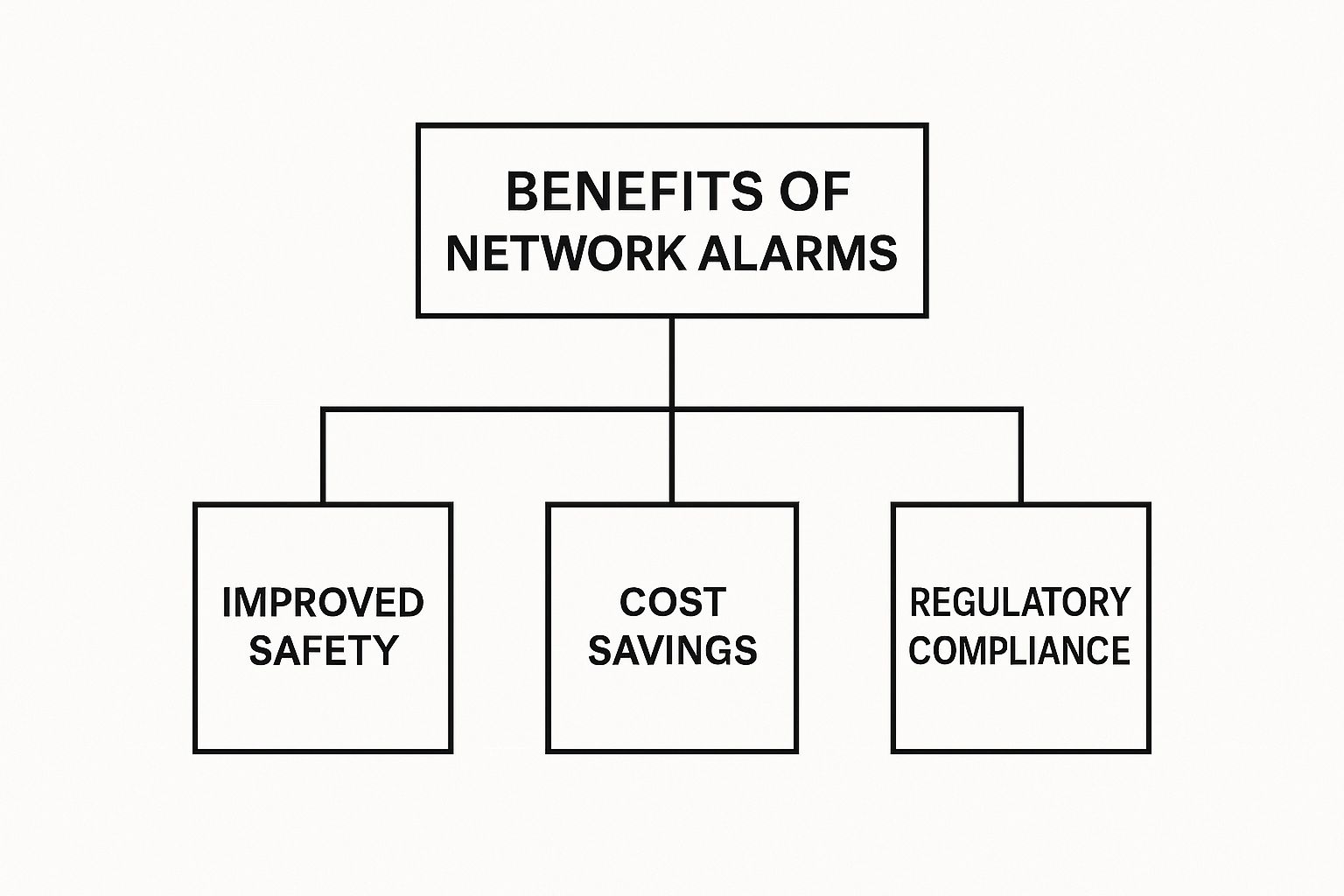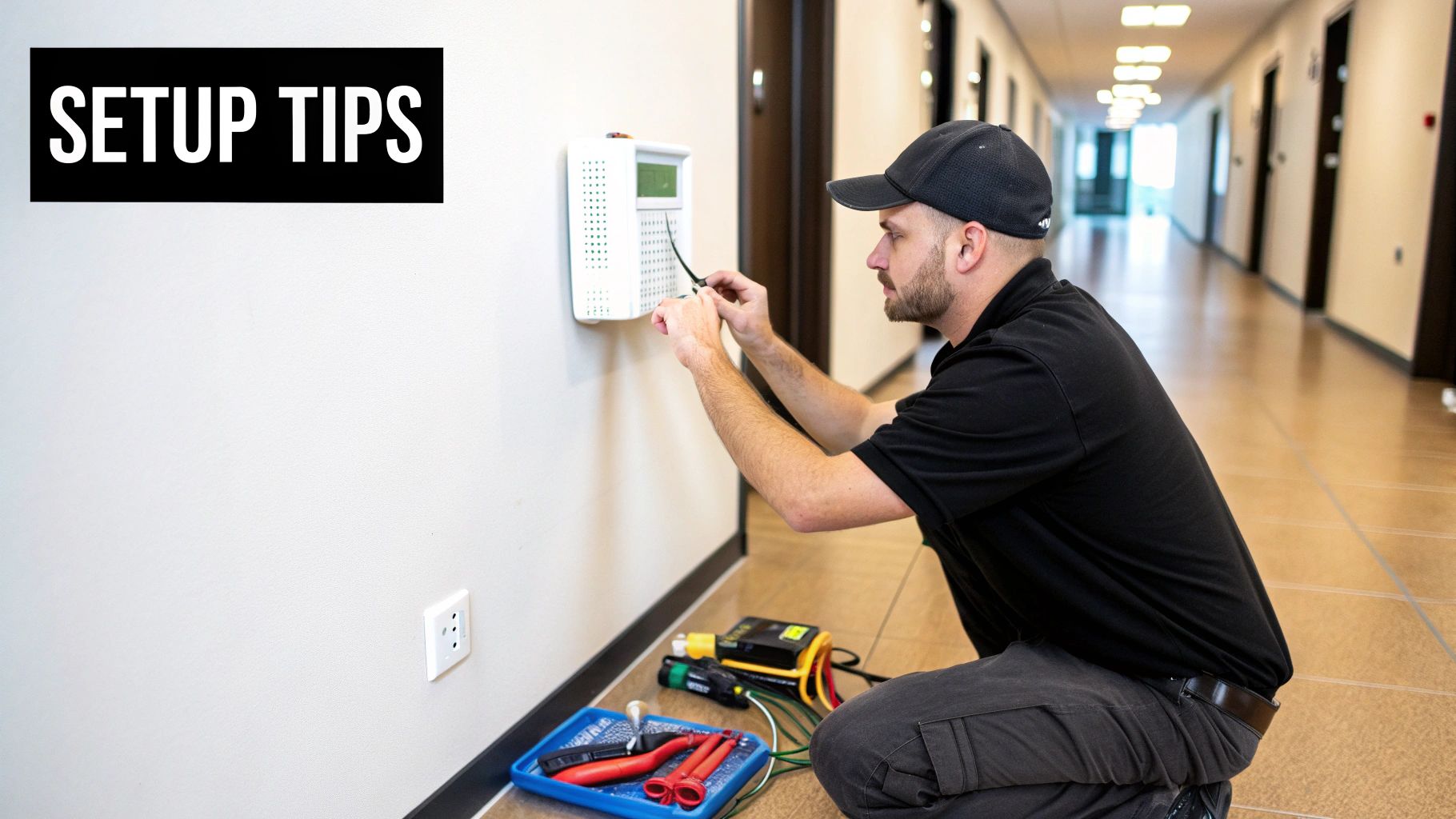Let’s be honest, in today’s crowded rental market, just having a nice apartment isn’t enough. If you’re not offering modern, integrated security, it’s like trying to rent a unit without solid Wi-Fi. Sure, it’s functional, but it’s a huge turn-off for the exact kind of tenants you want to attract. This is where a multifamily network alarm system changes the game, moving your property beyond a simple price war and into a class of its own.
Why Modern Security Is Your New Must-Have Amenity

The pressure to keep apartments filled with great tenants is immense right now. The U.S. is seeing its largest wave of new multifamily supply since the 1980s, driving the national occupancy rate down to 94.4% — the lowest it’s been in over ten years.
This fierce competition means property managers have to offer more than just a place to live. Today, peace of mind isn’t just a feeling; it’s a high-demand feature that residents will actively seek out.
From Afterthought to Essential Amenity
To really get why this matters, it helps to look at the ongoing evolution of security systems. The old, standalone alarms we used to see just don’t cut it anymore. Renters now expect smart, connected solutions that protect their own apartment and the entire community seamlessly.
When you frame a multifamily network alarm as a core amenity, you’re no longer talking about a cost—you’re talking about value. It’s a direct answer to what keeps renters up at night and gives you a powerful edge that can slash vacancies and stabilize your occupancy rates, even when the market is tough.
Making this one upgrade sends a clear message: you’re invested in your residents’ safety and well-being. That alone makes for a far more attractive and competitive property.
What Exactly Is a Multifamily Network Alarm?

Let’s cut through the jargon. A multifamily network alarm is essentially the central nervous system for your property’s safety and security. Instead of having dozens of separate, disconnected alarms in each unit, this approach creates one cohesive, intelligent system that watches over the entire building.
Think about it this way. Old-school alarms are like having individual security guards in each apartment who can’t talk to each other. If one spots a problem, the rest are completely in the dark. A networked system, on the other hand, operates like a modern security team connected by radios, all reporting to a single command center in real time.
This integrated design knits together the security for individual apartments and common areas into one seamless safety net. It gives you, the property manager, a bird’s-eye view of everything, while residents get top-tier protection without any hassle.
How It All Fits Together
A true multifamily network alarm is more than just a bunch of sensors scattered around. Its value comes from how those sensors communicate and operate as a single unit, all managed by a central hub. This is what sets it apart from older, piecemeal security setups.
Here are the key pieces that make it work:
- Centralized Monitoring: One dashboard or control panel shows you the security status of the entire property at a glance. No more logging into separate systems or trying to figure out where an alert is coming from.
- Individual Unit Protection: Every apartment becomes its own secure zone. Residents can arm or disarm their space using a simple mobile app, giving them a sense of control and security.
- Common Area Coverage: The system doesn’t stop at the apartment door. It protects lobbies, fitness centers, parking garages, and utility rooms, ensuring a threat anywhere is dealt with immediately.
The real game-changer is the unification. When an alarm goes off—whether it’s smoke in the laundry room or a break-in at a vacant unit—the system instantly knows the exact location and triggers the right response.
This creates a smarter, faster, and far more effective security shield for the whole community. If you want to get into the technical nuts and bolts, our detailed guide on the multifamily network alarm is a great next step.
How a Networked Security System Is Architected
Think of a modern multifamily network alarm system like your body’s nervous system. It’s a smart, interconnected web that keeps the entire property—from individual apartments to lobbies and parking garages—safe and responsive. Every part has a role, and they all communicate instantly.
The On-Site Components
At the ground level, you have the endpoint devices. These are the system’s eyes and ears, installed throughout the building.
We’re talking about devices like:
- Door and window sensors in each unit
- Smart smoke and carbon monoxide detectors
- Access control panels at main entrances and amenity doors
- Motion detectors and security cameras in common areas
These devices aren’t just standalone gadgets. They are constantly sending signals, either wirelessly or through physical wiring, to a central hub located right on the property. This hub is the local command center, gathering information from every single device and making sense of it all in real-time.
From Local Hub to Cloud Control
That on-site hub then connects to a powerful, cloud-based platform. This is where the magic really happens for property managers. From a single dashboard on your computer or phone, you can see everything—check a sensor’s status, review who entered the gym and when, or grant temporary access to a maintenance worker, all without setting foot on the property.
This layered approach is what makes these systems so effective. Below is a breakdown of the key hardware and software that make up this intelligent structure.
Core Components of a Modern Network Alarm System
This table outlines the essential pieces of the puzzle, showing how each component contributes to a secure and well-managed property environment.
| Component | Primary Function | Typical Location |
|---|---|---|
| Endpoint Sensors/Devices | Detect events like motion, entry, smoke, or water leaks. | Inside resident units, hallways, entryways, common areas. |
| Access Control Panels | Manage and record entry through doors using key fobs, cards, or mobile credentials. | Building entrances, amenity doors (gym, pool), parking garages. |
| On-Premise Hub/Controller | Gathers data from all local devices and executes commands. | A secure IT closet or central utility room on the property. |
| Cloud Management Platform | Provides remote monitoring, system configuration, user management, and reporting. | Accessed via a web browser or mobile app from anywhere. |
| Network Infrastructure | The wired (Ethernet) and wireless (Wi-Fi) connections that allow all components to communicate. | Throughout the entire building. |
Each of these elements works in concert, creating a system that’s much more than the sum of its parts. It’s a dynamic, responsive security ecosystem.

As you can see, the benefits go far beyond simple security, touching on operational efficiency, cost savings, and resident satisfaction. This integrated design is also incredibly flexible. You can start with basic protections and easily add more devices or features as your community grows or its needs evolve.
A critical, yet often overlooked, layer is the system’s own digital defense. Proper network security monitoring is non-negotiable. It acts as a digital watchdog, ensuring the data flowing between your devices, the hub, and the cloud is secure and uninterrupted. This protects the security system itself from cyber threats.
Essential Features That Drive Real Value

Not all security systems are created equal. When we talk about a top-tier multifamily network alarm, we’re looking at specific features that deliver tangible value to property managers and residents alike. These aren’t just flashy add-ons; they are practical tools designed to make life easier and safer for everyone.
At the heart of any great system is a single-pane-of-glass management dashboard. Imagine it as your property’s security command center. Instead of juggling multiple apps or sifting through paperwork to track down an incident, you get a complete, real-time overview of every sensor, camera, and access point from one screen. This shifts the dynamic from reactive firefighting to proactive management.
Empowering Staff and Residents
The real magic happens when you give both your team and your residents control and convenience. Mobile access is no longer a luxury—it’s an absolute must.
This means your maintenance staff can be granted temporary access to a unit right from the management office, eliminating the need to track down physical keys. At the same time, a resident who forgot to arm their alarm can do it from their phone on their way to work. This kind of flexibility solves countless daily frustrations and gives residents the modern experience they’re looking for.
Integration is another game-changer. When your network alarm talks to other smart devices in the building—like smart locks, thermostats, and lighting—you unlock a new level of automation. For instance, arming the system could simultaneously lock the front door and turn off all the lights, boosting both security and energy savings.
The most powerful systems are those that deliver instant, actionable intelligence. Instead of a vague alert, you get a notification saying, “Forced Entry Alert: Unit 3B, back window, 7:15 PM,” allowing for an immediate and precise response.
Finally, automated reporting and instant alerts are crucial. A good system logs every single event, from a service door being propped open too long to a sensor running low on battery. This creates a detailed, searchable record that makes incident management incredibly straightforward. To dig deeper into what makes these systems such a powerful asset, check out our detailed guide to network multifamily alarms.
Thinking About the ROI of a Security Upgrade? Here’s How to Calculate It.
When you’re looking at a modern multifamily network alarm, it’s easy to get stuck on the price tag. But treating it purely as an expense is a mistake. It’s actually a strategic investment, and one that can deliver a very real return on investment (ROI). While you’ll definitely see an upfront cost, the financial upside over the long haul often makes the initial spend look small in comparison.
Let’s start with the easy-to-measure returns. First, check with your insurance provider. Many offer substantial premium discounts for properties that install professionally monitored, integrated security systems. Then there’s the direct loss prevention—every time the system deters theft, vandalism, or property damage, it’s saving you thousands of dollars you would have otherwise spent on repairs and replacements. These are the numbers you can plug directly into a spreadsheet.
The Value Beyond Direct Savings
But the real power of a great security system lies in the benefits that aren’t so simple to quantify on a spreadsheet. In a crowded rental market, top-notch security is a huge differentiator that directly protects and grows your revenue.
Think about it: a property known for its safety and modern features naturally builds a better reputation. This not only helps you attract higher-quality tenants who are willing to pay for peace of mind, but it also makes them want to stay longer. Better retention means less turnover, fewer vacancy gaps, and lower marketing costs—all of which boost your bottom line. You’ll also see operational savings from reduced staff time spent dealing with security incidents or manually letting people in.
A modern security system is a powerful amenity that protects your Net Operating Income (NOI). It allows you to maintain rental rates and high occupancy, even when the market is flooded with new supply.
This becomes absolutely critical when the market gets tight. Projections show U.S. multifamily rent growth slowing to just 2.2% in 2025, largely because a record number of new units are hitting the market. When renters have that much choice, value-added amenities like a sophisticated multifamily network alarm are what keep your property full and your rental income stable. You can read the full 2025 multifamily outlook to get a deeper sense of these pressures.
In the end, this investment isn’t just about preventing break-ins; it’s about building a more profitable, resilient, and desirable property for years to come.
The Power of Pairing Your Alarm with NaaS
A smart, connected security system is only as good as the network it runs on. It’s a simple truth. A spotty or unreliable connection can turn your sophisticated multifamily network alarm into an expensive set of decorations, leaving cameras offline and sensors unable to send critical alerts.
This is where the relationship between your alarm system and its underlying network becomes paramount. Think of your building’s connectivity just like any other essential utility. You wouldn’t accept flickering lights from a shaky electrical grid, so why accept a security system that cuts out? It needs a robust, always-on digital foundation to function properly.
This is the core idea behind Network-as-a-Service (NaaS). Instead of piecing together consumer-grade routers or saddling your staff with complex IT problems, NaaS delivers professionally managed, property-wide connectivity as a straightforward service.
Creating a Resilient Security Backbone
When you partner with a NaaS provider, you’re essentially outsourcing all the connectivity headaches. The provider takes on the heavy lifting—they design, install, and manage a powerful Wi-Fi network that guarantees your security devices always have a strong, stable signal. This ensures that every camera, sensor, and access panel stays online and in constant communication with the central hub.
This approach creates a truly resilient and low-maintenance security infrastructure. Your team is freed from troubleshooting dropped connections, and you get the peace of mind that comes from knowing your property’s digital nervous system is supported by an expert-managed backbone. To dig deeper into this model, check out this guide on what NaaS is and how it benefits businesses.
Clearing Up Common Questions About Network Alarm Systems
When you’re thinking about a major upgrade like a multifamily network alarm system, it’s totally normal to have some practical questions pop into your head. Property owners and managers I talk to are always curious about the real-world side of things—the installation process, what it’s like for residents, and just how reliable these systems truly are.
Let’s dig into some of the most common concerns I hear.
What About Installation and Resident Control?
One of the first questions is almost always about installation, especially in older buildings. “Am I going to have to tear up walls?” The good news is that modern systems are overwhelmingly wireless. This massively cuts down on the disruptive and expensive rewiring that old-school systems required. A professional crew can typically get a whole system up and running with very little fuss for your residents, making retrofitting a surprisingly smooth process.
Of course, residents want control over their own homes. A core feature of any good system is a user-friendly mobile app. This lets tenants arm and disarm their own alarms, get alerts on their phones, and tweak their security settings. Meanwhile, property management keeps a bird’s-eye view of common areas and overall system health. It’s the best of both worlds.
What Happens if the Power or Internet Goes Out?
This is a big one. What happens when the internet drops or the power flickers out?
Any network alarm system worth its salt is built with backups. The most crucial one is a cellular backup that kicks in automatically if your building’s primary internet connection goes down. This ensures the system never loses its connection to the central monitoring station, keeping your property protected when it’s most vulnerable.
At the end of the day, these systems are designed from the ground up to be tough, easy for everyone to use, and secure. They’re built to solve the real challenges faced by both property managers and the people who live in their buildings.
Ready to secure your property with a modern, reliable network alarm and managed Wi-Fi solution? The expert team at Clouddle Inc specializes in designing and deploying integrated technology that boosts safety and resident satisfaction. Learn more about our solutions.


